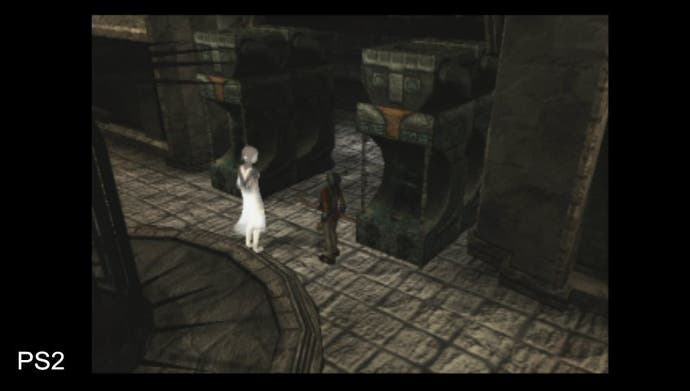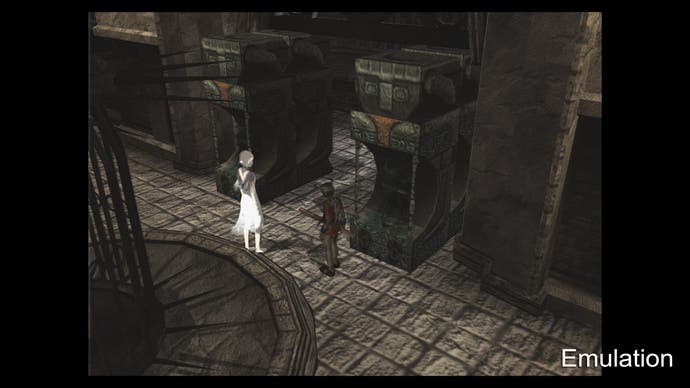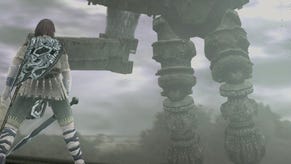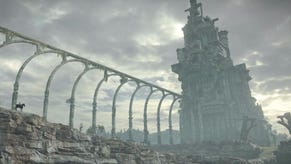Tech Analysis: Ico and Shadow of the Colossus Collection HD
PS2 vs. PS3 vs. 3D vs. emulation vs. anything else we can find.
The overall impression is that Bluepoint didn't really want to mess around too much with the game's original aesthetic but have made sympathetic adjustments to suit the new look generated by the PlayStation 3. Generally, when the camera is pulled back, the handling of the textures looks wonderful (just the intro screen represents a phenomenal improvement) but when the action zooms in more closely, the original low-resolution artwork does become a bit more of an issue.
There have been attempts to improve overall presentation though: for example, the somewhat off-putting frame-blending motion blur/anti-aliasing solution employed in Ico is present in the PS3 remaster but the ghosting effect is far less noticeable. In other cases, the move to a higher resolution presents additional image quality goodness by default: texture filtering is obviously subject to an enormous level of improvement the higher you ramp the resolution.




Moving on to Shadow of the Colossus and it appears that Bluepoint has essentially worked with the original artwork without feeling the need to do make any significant changes to the look of the game.
Curiously, the developer does appear to have changed the field of view in the cut-scenes, typically pulling the camera back to provide a more expansive view. This has the bonus effect of reducing the size of low-resolution textures and generally seems to give the artwork more room to "breathe" - though purists may have preferred the original developers' shot composition to be respected, or at least available as an option.
There are other changes between the PS2 and PS3 versions. The pseudo-HDR bloom appears to be handled in a somewhat different manner, in many situations producing a noticeably lower intensity on the PlayStation 3. In some cases, the original developers use the Z-buffer to divide the distant view from the foreground to create a black/white mask, and then lower the resolution of the mask to 64x64 to create the blurring effect on PS2. What we're seeing on the PS3 version seems to be an increase in this resolution before it's composited back to the main image, giving a cleaner lighting effect, albeit with less bloom.
Curiously, motion blur appears to have been improved in quality on the PlayStation 3 too. Original "making of" documents for the game reveal that the motion blur is calculated by adjusting the environmental elements of the current frame based on camera velocity from the last frame, and then combining them. It may well be that the increased quality in the motion blur comes down to the higher frame-rate, thus producing more samples to work with compared to the variable frame-rate we saw on the PS2 game. However, even taking that into account, motion blur does seem to be more liberally applied than it was previously and the resulting effect is well realised.
Texture filtering also appears to be significantly improved on PlayStation 3, especially evident on the far-reaching plains. The increase in resolution will have played a part here, but there's also the suggestion that basic bilinear filtering could have been improved with an anisotropic solution.
On the minus side, as we mentioned back in last year's HD emulation article we were hoping that LOD popping would be improved, but during the traversal of the landscape there are moments where it actually appears to be much worse than it is on the PlayStation 2 - this appears to be down to the fact that the overall presentation is so much clearer now that the artifacts of the original game become a bit more obvious. Also, a minor element we noted is that the depth-of-field effect we see on PS2 fleetingly in cut-scenes doesn't appear to have been replicated on PS3.
From a general performance perspective, Bluepoint has resisted the temptation to run Ico and Shadow of the Colossus at 60 frames per second, seeking to lock both games at 30FPS - the target update rate on both of the original games. The question is, to what extent has the studio reached its goal, bearing in mind the three different rendering resolutions that each version supports?
For our first set of tests we're comparing the original PlayStation 2 versions of the games up against the new PS3 games running at the standard 720p, kicking off with Ico. Be prepared for a very uniform, very long, straight line on the frame-rate graph...
In actual fact we see a locked, v-synced 30 frames per second with Ico no matter which PS3 resolution you choose, which is obviously a good thing. However, bearing in mind that the game runs with ease at both 1080p and stereo 3D, there is a little lingering disappointment that 60Hz wasn't offered as an option at 720p - the PS3 could easily manage it based on the evidence we have from the more demanding display modes.
We see the same adherence to 30 frames per second on Shadow of the Colossus - which is a significant improvement over the original PlayStation 2 game. Elements such as cloth physics emulation, fur rendering and multi-sample motion blur only really came into their own on the HD generation consoles with their more powerful CPUs and programmable pixel shader graphics cores, but Shadow of the Colossus combined all these technologies on PS2 - the result being a wholly unique-looking game - albeit one with an often disappointing frame-rate.
With the upgrade to PlayStation 3, the experience is now so much more consistent both in terms of look and feel. Over and above the fact that the game is now so much less frustrating to play (lining up precision shots with the bow and arrow with the engine crawling at 15FPS was never much fun), the sustained frame-rate allows for the phenomenal animation work of the original game to really shine through - something we hope is demonstrated by the comparison movie on the first page.















